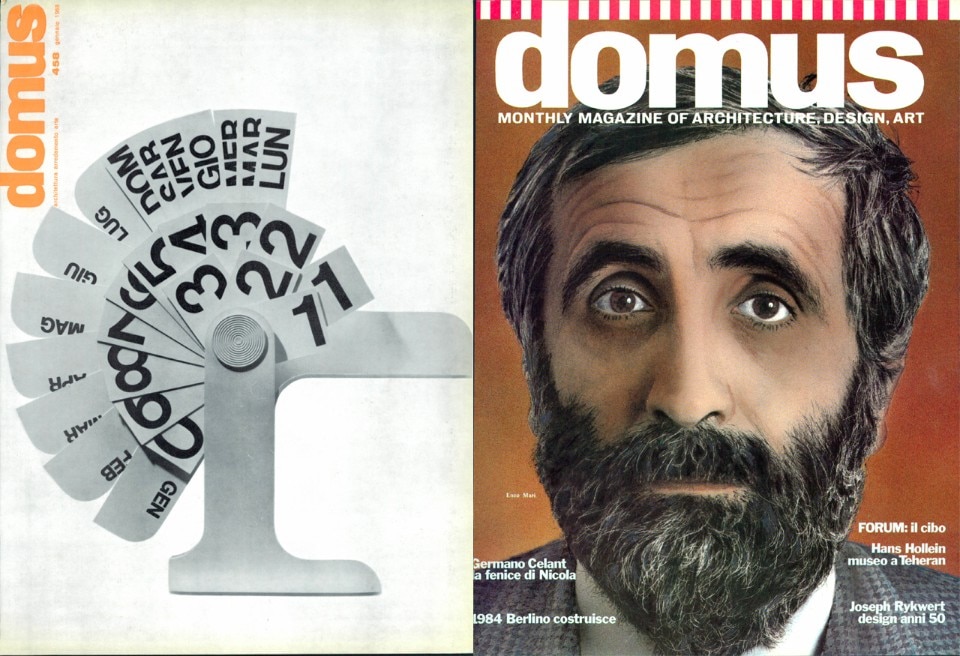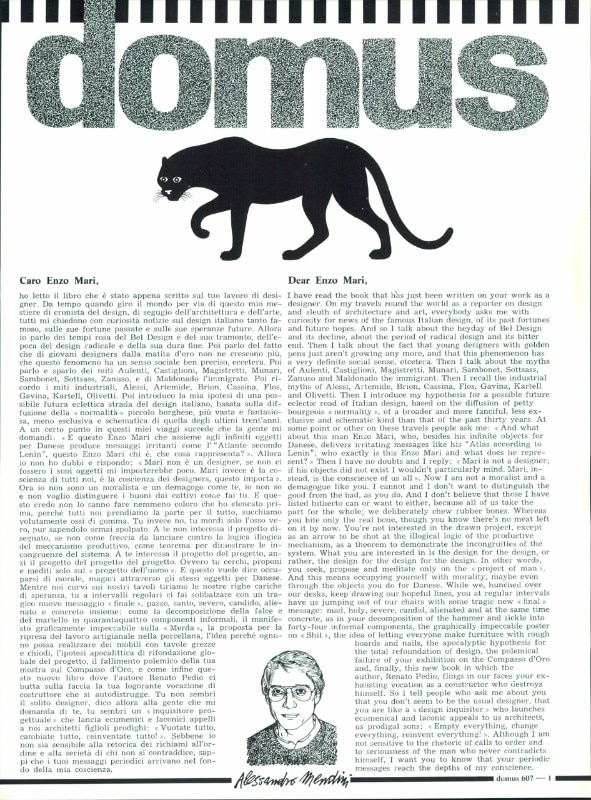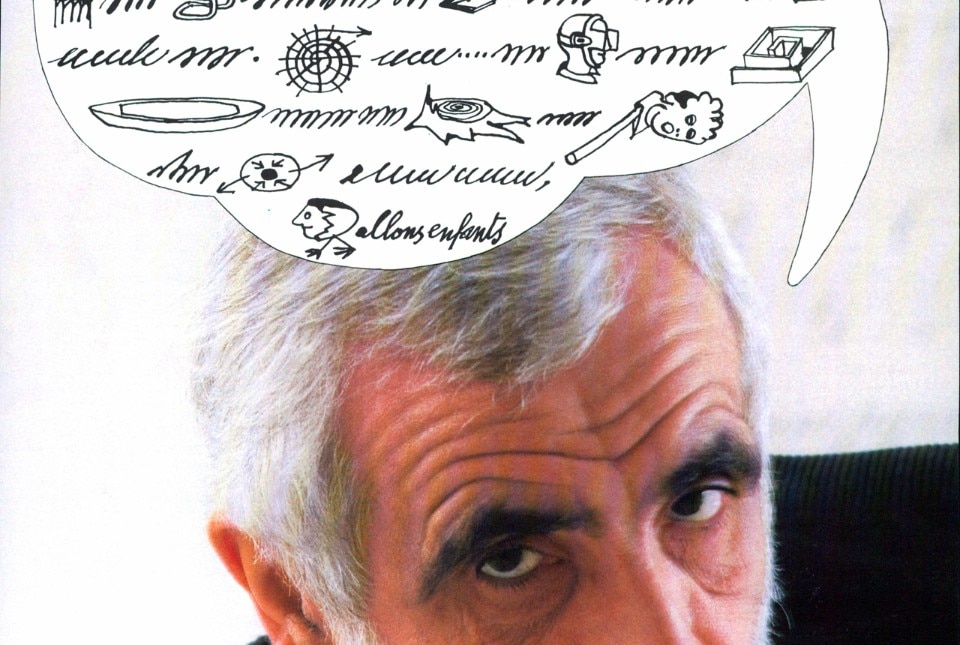The well-known calendar designed for Danese opens the cover from 1968, an emblematic piece of the partnership between Enzo Mari and Bruno Danese (the famous producer of Mari and Munari’s work, recently passed away). On the same issue, the critic Tommaso Trini describes the distinctive traits of Mari, a designers who is also a “researcher” (Domus 458, 1968). Year after year follow the cutting contributions that illustrate his combative philosophy and way of work – believing that “A project is an act of war” (Domus 694, 1988). In June 1980, Alessandro Mendini signs the editorial “Dear Enzo Mari” and thanks his colleague for his tenacity in representing designers’ conscience: this time the cover shows the portrait of Mari (Domus 607, 1980).
“Either design is a cultural plus-value or it isn’t design” Dialogue with Enzo Mari. Text Juli Capella (Domus 791, March 1997)
Enzo Mari has no difficulty in admitting that he is going through a favorable period. We won ‘t say he is in fashion for the very idea would horrify him. However there is no doubt that Mari is experiencing a particular time of reappraisal. Some people depict him as a politicalized designer – “everything we do is politics, the difference lies in being aware of the fact or not” – and see him as intransigent, polemical and pessimistic. Whereas he is exactly the opposite: one of the most combative and hopeful designers in existence. He asserts his dual nature as an artist, acting concretely on reality, and as a philosopher. Mari works in the world of objects, without forgetting however that these depend on ideas: “The first problem facing a designer is to define his own model of an ideal world, and not to create an aesthetic... The designer cannot fail to have his own ideology of the world. If he has none, he is a fool who only gives shape to other people’s ideas”. For many years Mari has been attempting to materialize his thinking, and does so through a personal synthesis of functionality and great, very great beauty, intended however as a result and not as a premiss.

Mari, are you a good professional?
“No. The difference between intellectuals and professionals is that the latter say they make real products. But if they make real objects, they are disgusting things enslaved by industry and contrary to the goals of design, which are to transform the world”.
So you’re an artist?
“Someone said that I am the conscience of design, but I am an artist and I work as an artist. Precisely for this reason, because I know what art is, I cannot support object-sculptures, because they are only the fruit of applied arts... The artist is someone who gives form to a collective value, in which everyone can recognize themselves...”. Mari recently numbered his 1870th project in his Milan studio, a large flat in piazzale Baracca, a sort of cross between a craft workshop and an office. In it he puts up a stiff resistance to the invasion of technological modernity. “Technology has brought some extremely positive progress. But at the same time it has some monstrous aspects. Modern technology is blind... and the computer is very restrictive... Internet is the maximum of information but also the maximum of disinformation”. Many of Enzo Mari’s designs have had a great success and proved to be masterpieces on a world level. Others have been forgotten and others still thwarted, as in the case of the “Design and Design” exhibition, which Mari had organized in 1979 when he was president of the Adi. Faced with his critical vision of design, his colleagues pointed an accusing finger: “You bite the hand that feeds you”. So he eventually renounced the appointment and the exhibition never took place. Notwithstanding, Mari is particularly proud of his own work: “70% of the things I did thirty years ago are still around: this is my way of opposing fashions”.
Which objects do you feel most satisfied with?
“Projects are fulfilled through an infinite number of compromises. I can only put a small percentage of revolution or utopia into an object: I am pleased enough when, after immense effort, I manage to get 10 per cent into it”. He feels distressed when a design by him is given a very wide positive welcome. “When I design an object and people say: ‘oh, well done!’, I unfailingly ask myself: Where did I go wrong? If everybody likes it, it means I have confirmed the existing reality and this is precisely what I don’t want”. For him, being successful does not mean selling more, or earning more money. “The most interesting and difficult question is how to respond to a need which people don ‘t know they have; because if you do what people want, then you’ll be doing silly things”. Mari adopted a highly conflictual attitude to the postmodern design boom of the 1980s. But he was also deeply critical of rationalism and of the Ulm School. “I found myself faced with two formal systems: a painful choice. There was the Modern movement, and opposition to the Modern movement. The first was a perverse repetition, with industry representing a value and not an instrument. The second was a revisitation of the avant-gardes, from constructivism to surrealism and dada. New design is where everything is possible, even its opposite, and I maintain that this represents pure restoration, reaction and ignorance”.
All right then, but where is the progressive and avant-garde project to be found?
“l think that at present the search for a new order, a new classicism, is the most revolutionary operation that can be carriedout”, says Mari with a paradox.
Do you have the sensation of being alone on this path?
“I am a kind of tightrope-walker balanced on the razors edge; to my right there is kitsch, and to my left too. And I have to deny kitsch”. Mari would like to meet a group of young people prepared to wage this battle, but he finds the young bewildered and confused. “In Milan, the umbilical cord of the design world, a standardized object is produced, but the object is not a chair or a lamp: it is the young designer churned out in large numbers. Today these young designers don’t question anything, they complain, they say they can’t find manufacturers, they want to be stars. It’s a depressing situation”. There’s nothing new about this however, it’s always been like that. “There is certainly a small percentage of good young designers, as there were when I began, but today they are led astray. At the moment the problem facing the courageous young designer is not that of finding someone to produce his or her work, the problem is the 100 thousand useless characters that surround and suffocate him, that make him do foolish things”.
But hasn’t everyone the right to express themselves, to create and to sort?
“All right, but if you’re paid you have to compare yourself with Michelangelo. This is where the artist, the poet, stands out, when he is capable of condensing the world into a few words”. Mari’s wish would be to find some fellow-travellers with whom to agree on “three common words” to change this society. "I would like to work in a school, lo re-found a place in which to learn, that would be different to those in existence. I envisage a school of ideology or art, where students are not made to do projects or talk about marketing, but where they can learn to think... Creativity is a questioning of knowledge”.
What interpretative key has guided this master of Italian design, what is his personal style?
“l have no forms or values of my own to propose: I have decided not to reconstruct an idiom of my own every time l have to reinvent. I try to rethink and not to behave academically”.
Then where is your specificity?
“My values concern the quality of work. When I am asked what is the best thing I have done, I never think of the best form, but I can describe situations in which l have been content to work because a positive dialogue was being constructed”. A dialogue which he has always conducted in connection with the big industry of Italian design. “But now industry doesn’t want projects any more, it wants styling”. And the present state of design is degraded. “It’s impossible for all the catalogues of the best-known companies to include the creations of all designers. Because everyone is the bearer of a different philosophy, and three or four of them are antithetic: Mendini’s, Starck’s, and mine”.
What is the future of design?
“Design will go in the direction in which intelligence leads it”. However the manufacturing companies today are filling up with yuppies, who are dangerously replacing the genuine entrepreneurs. Meanwhile high prices continue to be a problem for good products. “The problem of real – not utopian – design today is that the public in a position to understand its qualities and to pay its price numbers not more than 30 thousand in the whole of Europe; the same public that are prepared to buy a book by Plato in a quality edition. The rest is an unqualified and idiotic culture, and without money moreover”. Mari nevertheless continues to believe in the possibility of struggling by means of design to help people be happier, each in their own role. “Utopia is the happy island that isn’t there, that isn’t possible. I am a child of the French Revolution, like all of us, Catholics or Jews, Marxists or capitalists, I regard the word egalité as my faith. I don’t think it is effectively possible. But I want to believe in the possibility of equality through design... It is obvious that quality is comprehensible only to those who want to achieve quality. The high quality of design, as of architecture, as of life itself, belongs only to a small group of people, it is not a mass product. But this does not mean that I don’t struggle to make it become a product for all, though without expecting it to be ready overnight”. We are not in a hurry, we can wait a hundred, a thousand years. Mari however is a bit nervous and worried: ‘‘All the manufacturers today ask me to design best-sellers. But a poet can’t turn out best-sellers and follow commonplaces. Now they all ask me this question and it drives me mad”.
Mari at the age of 64 still gets angry. He stands up and shouts, laughs, suffers and struggles as he did when he was a child, as he did when he arrived in Milan from Novara and began at once to doubt everything in his large head and to use his elegant hands. Thanks to 45 years of work the world is a little bit better-looking and, according to his philosophy, also a little more just. Perhaps it really is. With many thanks.

Quick Test
Enzo Mari was asked these questions with a request, a challenge, to answer them in one line. Given his obsession with extensive and detailed explanations, the test should be seen as a rare and courageous summary of Mari’s philosophy.
Can design be defined in a line? That depends on who has to define it.
You have a try... I can’t do it.
What is your real craft? Trying to define this word if not in one at least in four lines.
Do you think of yourself as an artist? The previous answer fits that status.
What is Italian design? A characteristic of Italians: the art of improvising.
And what does that depend on? Three things: lack of money; the existence of millions of craftsmen; living in the world’s largest store of works of art.
Industrialist-designer relations? Il the industrialist is a dedicated craftsman the ideal conditions for design work will arise. In all the other cases, shit.
What is the purpose of magazines? Wouldn’t it be better to ask what their purpose ought to be?
What purpose ought they to serve? To describe things worth talking about.
Where does design come into politics? They are the same thing: political activity consists of bringing others round to one’s own position. Isn’t that perhaps the share goal of design?
Are you a communist? If by ‘communist’ you mean refusing work as alienation and asserting one’s labors as transformation, then I’m a communist.
But don ‘t you personally help industrial capitalism? Who doesn’t? I always hope to get the start of its transformation in exchange.
Are you a moralist? All the great masterpieces sprang from an ethical tension. I am to be consistent with my role as a designer I cannot but look to that same tension.
Where is design going? Where the majority wants it to go. But the majority isn’t necessarily always right.
How can it be directed? By fighting for one’s ideas.
What will the designer’s work be like in the future? Predictably ever more like television advertising.
Any fears? None.
Any desire? Everything.
Any doubts? All.
Any certainty? One designs to defend the freedom to think.
A designer... The inventor of the frying-pan.
An artist... A great many. But not more than three for each century.
A politician... Socrates.
Why did you accept these questions? Because I don’t know what design is.


